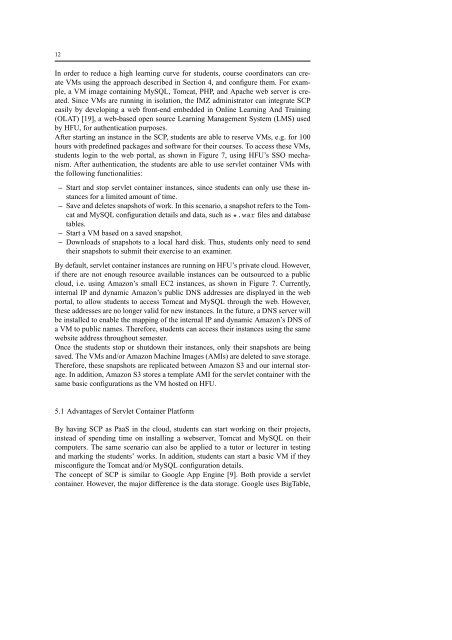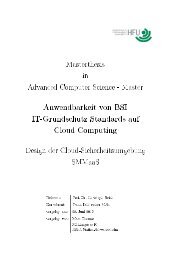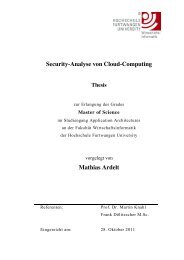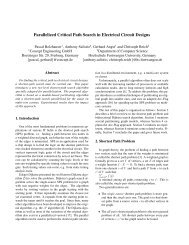Private Cloud for Collaboration and e-Learning Services: from IaaS ...
Private Cloud for Collaboration and e-Learning Services: from IaaS ...
Private Cloud for Collaboration and e-Learning Services: from IaaS ...
You also want an ePaper? Increase the reach of your titles
YUMPU automatically turns print PDFs into web optimized ePapers that Google loves.
12<br />
In order to reduce a high learning curve <strong>for</strong> students, course coordinators can create<br />
VMs using the approach described in Section 4, <strong>and</strong> configure them. For example,<br />
a VM image containing MySQL, Tomcat, PHP, <strong>and</strong> Apache web server is created.<br />
Since VMs are running in isolation, the IMZ administrator can integrate SCP<br />
easily by developing a web front-end embedded in Online <strong>Learning</strong> And Training<br />
(OLAT) [19], a web-based open source <strong>Learning</strong> Management System (LMS) used<br />
by HFU, <strong>for</strong> authentication purposes.<br />
After starting an instance in the SCP, students are able to reserve VMs, e.g. <strong>for</strong> 100<br />
hours with predefined packages <strong>and</strong> software <strong>for</strong> their courses. To access these VMs,<br />
students login to the web portal, as shown in Figure 7, using HFU’s SSO mechanism.<br />
After authentication, the students are able to use servlet container VMs with<br />
the following functionalities:<br />
– Start <strong>and</strong> stop servlet container instances, since students can only use these instances<br />
<strong>for</strong> a limited amount of time.<br />
– Save <strong>and</strong> deletes snapshots of work. In this scenario, a snapshot refers to the Tomcat<br />
<strong>and</strong> MySQL configuration details <strong>and</strong> data, such as *.war files <strong>and</strong> database<br />
tables.<br />
– Start a VM based on a saved snapshot.<br />
– Downloads of snapshots to a local hard disk. Thus, students only need to send<br />
their snapshots to submit their exercise to an examiner.<br />
By default, servlet container instances are running on HFU’s private cloud. However,<br />
if there are not enough resource available instances can be outsourced to a public<br />
cloud, i.e. using Amazon’s small EC2 instances, as shown in Figure 7. Currently,<br />
internal IP <strong>and</strong> dynamic Amazon’s public DNS addresses are displayed in the web<br />
portal, to allow students to access Tomcat <strong>and</strong> MySQL through the web. However,<br />
these addresses are no longer valid <strong>for</strong> new instances. In the future, a DNS server will<br />
be installed to enable the mapping of the internal IP <strong>and</strong> dynamic Amazon’s DNS of<br />
a VM to public names. There<strong>for</strong>e, students can access their instances using the same<br />
website address throughout semester.<br />
Once the students stop or shutdown their instances, only their snapshots are being<br />
saved. The VMs <strong>and</strong>/or Amazon Machine Images (AMIs) are deleted to save storage.<br />
There<strong>for</strong>e, these snapshots are replicated between Amazon S3 <strong>and</strong> our internal storage.<br />
In addition, Amazon S3 stores a template AMI <strong>for</strong> the servlet container with the<br />
same basic configurations as the VM hosted on HFU.<br />
5.1 Advantages of Servlet Container Plat<strong>for</strong>m<br />
By having SCP as PaaS in the cloud, students can start working on their projects,<br />
instead of spending time on installing a webserver, Tomcat <strong>and</strong> MySQL on their<br />
computers. The same scenario can also be applied to a tutor or lecturer in testing<br />
<strong>and</strong> marking the students’ works. In addition, students can start a basic VM if they<br />
misconfigure the Tomcat <strong>and</strong>/or MySQL configuration details.<br />
The concept of SCP is similar to Google App Engine [9]. Both provide a servlet<br />
container. However, the major difference is the data storage. Google uses BigTable,





